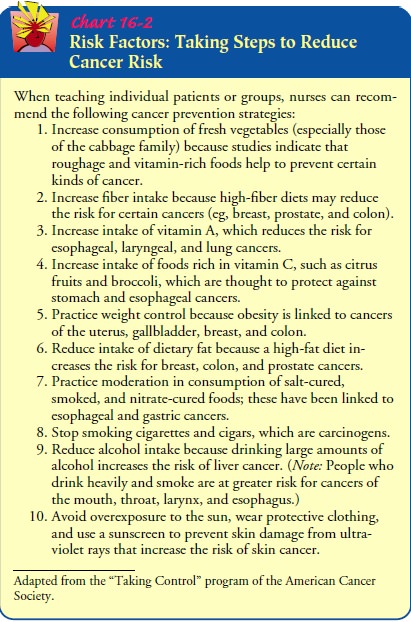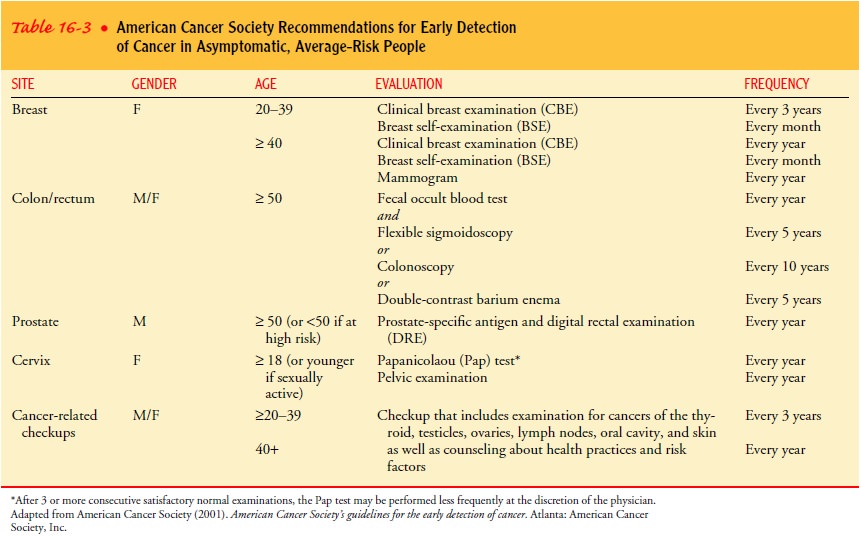Chapter: Medical Surgical Nursing: Oncology: Nursing Management in Cancer Care
Detection and Prevention of Cancer
Detection and Prevention of Cancer
Nurses and physicians have traditionally been involved with ter-tiary
prevention, the care and rehabilitation of the patient after cancer diagnosis
and treatment. In recent years, however, the American Cancer Society, the
National Cancer Institute, clini-cians, and researchers have placed greater
emphasis on primary and secondary prevention of cancer. Primary prevention is
con-cerned with reducing the risks of cancer in healthy people. Sec-ondary
prevention involves detection and screening to achieve early diagnosis and
prompt intervention to halt the cancer process.
PRIMARY PREVENTION
By acquiring the
knowledge and skills necessary to educate the community about cancer risk,
nurses in all settings play a key role in cancer prevention. Assisting patients
to avoid known carcino-gens is one way to reduce the risk for cancer. Another
way in-volves adopting dietary and various lifestyle changes that epidemiologic
and laboratory studies show influence the risk for cancer. Several clinical
trials have been undertaken to identify medications that may help to reduce the
incidence of certain types of cancer. Recently, a breast cancer prevention
study sup-ported by the National Cancer Institute was conducted at multi-ple
medical centers throughout the country. The results of this study indicated
that the medication tamoxifen can reduce the in-cidence of breast cancer by 49%
in postmenopausal women iden-tified as at high risk for breast cancer (Fisher
et al., 1998). Nurses can use their teaching and counseling skills to encourage
patients to participate in cancer prevention programs and to promote healthful
lifestyles.
SECONDARY PREVENTION
The evolving understanding of the role of genetics in cancer cell
development has contributed to prevention and screening efforts. Individuals
who have inherited specific genetic mutations have an increased susceptibility
to cancer. For example, individuals who have familial adenomatosis polyposis
have an increased risk for colon cancer. Women in whom the BRCA-1 and BRCA-2
genes have been identified have an increased risk for breast and ovarian
cancer. To provide individualized education and recom-mendations for continued
surveillance and care in high-risk pop-ulations, nurses need to be familiar
with ongoing developments in the field of genetics and cancer (Greco, 2000).
Many centers across the country are offering innovative cancer risk evaluation
programs that provide in-depth screening and follow-up for in-dividuals who are
found to be at high risk for cancer.
Numerous factors, such as race, cultural influences, access to care,
physician–patient relationship, level of education, income, and age, influence
the knowledge, attitudes, and beliefs people have about cancer. These factors
also influence the type of health-promoting behaviors they practice. For
example, Phillips, Cohen, and Moses (1999) examined beliefs, attitudes, and
practices re-lated to breast cancer and breast cancer screening in African
American women (Nursing Research Profile 16-1). They found that cultural,
spiritual, and socioeconomic factors seen in the women studied could be
identified as barriers to breast health screening behaviors. Nurses can use
this type of information in planning education, prevention, and screening
programs.
Public awareness about health-promoting behaviors can be in-creased in a
variety of ways. Health education and health main-tenance programs are
sponsored by community organizations such as churches, senior citizen groups,
and parent–teacher asso-ciations. Although primary prevention programs may
focus on the hazards of tobacco use or the importance of nutrition, sec-ondary
prevention programs may promote breast and testicular self-examination and
Papanicolaou (Pap) tests. Many organiza-tions conduct cancer screening events
that focus on cancers with the highest incidence rates or those that have
improved survival rates if diagnosed early, such as breast or prostate cancers.
These events offer education and examinations such as mammograms, digital
rectal examinations, and prostate-specific antigen blood tests for minimal or
no cost. Programs of this nature are often tar-geted to individuals who lack
access to health care or cannot af-ford to participate on their own.
Similarly, nurses in all settings can develop programs that identify
risks for patients and families and that incorporate teach-ing and counseling
into all educational efforts, particularly for patients and families with a
high incidence of cancer. The Amer-ican Cancer Society has developed a public education
program, “Taking Control,” that integrates diet, exercise, and general health
habit tips that people can follow to reduce their risk for cancer (Chart 16-2).
Nurses and physicians can encourage individuals to comply with detection
efforts as suggested by the American Cancer Society (Table 16-3).


Related Topics